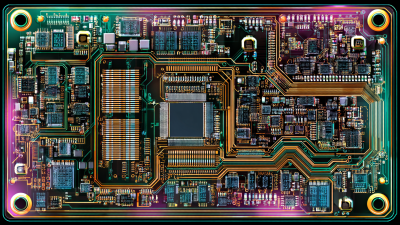
In the rapidly evolving landscape of engineering, the demand for efficient and innovative design solutions has never been more crucial. According to a recent industry report by MarketsandMarkets, the global electronic design automation (EDA) market is projected to reach $16.2 billion by 2026, with circuit design software being a pivotal component driving this growth. Modern circuit design software not only enhances productivity but also facilitates the integration of advanced technologies such as AI and IoT into electronic designs. As engineers navigate complex design challenges, leveraging sophisticated tools becomes essential for unlocking innovation and ensuring competitiveness in a technology-driven market.

This exploration of circuit design software will highlight its vital role in shaping the future of engineering and driving unparalleled advancements across various sectors.
When it comes to circuit design, selecting the right software is crucial for modern engineers aiming to streamline their workflow and enhance innovation. With a myriad of options available, understanding specific project requirements is essential. Engineers must consider factors such as user interface, simulation capabilities, and compatibility with other tools. For example, some software offers intuitive drag-and-drop functionality that can significantly reduce the learning curve, while others provide advanced simulation features that help in predicting real-world performance.

Additionally, different projects may necessitate varying degrees of complexity and collaboration. Engineers working on large-scale projects may benefit from software that supports team-based workflows and version control, ensuring seamless collaboration. Meanwhile, those focused on smaller projects might prioritize affordability and ease of use. Ultimately, the right circuit design software can empower engineers to unlock their full creative potential, facilitating efficient design processes and leading to groundbreaking innovations in the field.
When selecting circuit design software, engineers should prioritize key features that enhance productivity and foster innovation. One of the most critical aspects is an intuitive user interface. A well-designed UI allows engineers to navigate the software with ease, facilitating quicker project turnarounds and minimizing frustrations. Additionally, customization options that allow users to tailor their workspace can significantly improve efficiency, enabling personalized workflows that cater to individual preferences and project demands.
Another essential feature is robust simulation capabilities. Modern circuit design tools should offer advanced simulation tools that allow engineers to test their designs under various conditions before implementation. This not only aids in identifying potential issues early in the design phase but also saves time and resources, ensuring higher reliability in the final product.
Furthermore, integration with other software platforms, such as CAD systems, can streamline workflows and enhance collaboration, allowing multiple team members to contribute to a project seamlessly. These features collectively empower engineers to innovate while navigating the complexities of modern circuit design.
As modern engineering increasingly relies on sophisticated circuit design, getting started with the right software can significantly boost productivity and innovation. According to a recent report by Markets and Markets, the global electronic design automation (EDA) software market is projected to reach $15.71 billion by 2026, indicating a growing demand for tools that facilitate efficient circuit design. This surge emphasizes the importance of mastering key software, such as Cadence, Altium Designer, and KiCad, which offer robust functionalities for schematic capture, PCB layout, and simulation.
To ease the learning curve, aspiring engineers should start by exploring the comprehensive tutorials and user communities that accompany these tools. For example, Cadence provides an extensive library of resources ranging from beginner guides to detailed webinars, ensuring users can navigate the software effectively. Additionally, engaging with forums like the EDAboard can foster knowledge sharing and troubleshooting assistance, creating a collaborative environment for learning circuit design software. Embracing these resources not only accelerates the design process but also empowers engineers to unlock their creative potential in this rapidly evolving field.
In today’s fast-paced engineering environment, effective collaboration is paramount for successful circuit design. Utilizing advanced circuit design platforms can greatly enhance teamwork by providing a unified workspace where engineers can share ideas and modifications in real-time. These platforms often include features like version control and commenting systems, allowing team members to track changes and provide feedback seamlessly, thereby reducing misunderstandings and minimizing errors in the design process.
Moreover, integrating communication tools within circuit design software can facilitate brainstorming sessions and foster creativity. Utilizing built-in chat functions or video conferencing options helps keep discussions fluid, enabling quick problem-solving and immediate input from all stakeholders. By promoting an open channel of communication, engineers can leverage each other's expertise, leading to innovative solutions and improved project outcomes. Investing time in mastering these collaborative tools is essential for modern engineers aiming to unlock their full potential in circuit design.
In the fast-evolving realm of circuit design, engineers often encounter various challenges that can hinder productivity and innovation. According to a report by the IEEE, over 60% of engineers experience issues with simulation software, which can lead to project delays and increased expenses. Common problems include software crashes, inadequate documentation, and compatibility issues with different tools. Understanding these hurdles is essential for optimizing the design process and improving outcomes.
Another significant concern is the learning curve associated with advanced circuit design software. A study conducted by the Engineering Simulation and Analysis (ESA) group indicates that nearly 70% of new users face difficulties in mastering these sophisticated tools, leading to improper use and, ultimately, flawed designs. It is crucial for organizations to invest in comprehensive training programs and resources that can help engineers navigate these challenges effectively. By addressing these common issues, businesses can enhance their operational efficiency and unleash the full potential of innovative circuit design practices.




